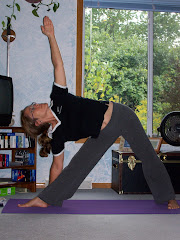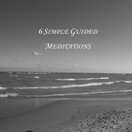For the longest time I thought I was alone; as Nadine alluded to some teachers may not be admitting their aches and pains. But when Gary Kraftsow shared at a workshop in Indiana this year that, "All the well-known yoga teachers in the US have had injuries and most have had surgery" I suddenly felt that I wasn't alone in this "dilemma." I don't know how much truth there was to that statement, but Gary struck me as a honest guy and that was his assessment after 30 years involvement with yoga.
The question is: How many injuries are due to the asanas, ego, or being a teacher? I think it depends on the person. In my own case I think a lot of my injuries are related to "experimenting" with various alignments in order to be a better teacher, demonstrating in classes, and from some personal challenges this body was born with.
Regardless of the cause, the sense of integration and peace yoga brings keeps me coming back. Over time my focus has shifted more heavily towards pranayama, meditation, and way of life. Asana is still there, but with a different emphasis.
There are so many styles of asanas--hundreds--and theories on alignment and sequencing; the one thing I know for sure is that no one really knows the right way. Perhaps this is because yoga is not a "one-size-fits-all" methodology. Maybe it's because yoga is meant to grow with you--not to keep you the same. So when you mature, so does the practice.
I used to think that asana involved mastering (or at least moving towards) more and more challenging postures. It wasn't an ego thing, it was an honest presumption that this would mean a deeper release of blocks, a strength of discipline, and a focused mind. This may be true, but does it make sense to even ask the body to become stronger and more flexible in your 40's, 50's, 60's, etc compared to the 20's and 30's?
Viniyoga has a strong foundation in respecting (and accepting) what stage of life one is in. Traditionally this style of yoga suggested a more intense and challenging asana practice for folks up to about age 25--the sunrise of life. Then from 25 to 70 or so, the midday of life, asanas were really to service pranayama, or the breathing practices. Finally comes sunset after 70 years old. This focused mainly on meditation. With that said all three stages may include all three elements: postures, breathing, and meditation. However the drive that is so frequently seen in western yoga classes to do the "next pose" and push further each time was (and is) definitely not what yoga was meant to be.
I admit to thinking in the past that if I was a "good" yogini I must be able to do more and more complex postures or I must be failing somehow. How ironic is that? To feel like a failure in a modality that is all about accepting who you are!
It's all a journey and the key is to "do better, when you know better." In my desire to "do better", I've been reading Yoga for Transformation by Kraftsow and here are just a couple of quotes that lead me to believe he's on to something and my practice is going to change again:
"...the transformational potential of practice is furthered by progressively adding other elements --such as pranayama, chanting, meditation, prayer, and ritual--to do the same or similar core postures, without having to master progressively more complex or difficult postures." (page xxi)
"And just as our bodies change through time, the ancients suggested that the purpose and methods of asana practice must also change." (page 5)
"...if we are the high-paced, hyperactive type, we might be drawn toward a very active practice--one that makes us sweat and that generates lots of heat--whereas what we may really need is a more soothing and calming practice. Or, if we are the slow-moving, sluggish type, we might be drawn to a very gentle and relaxing practice, whereas what we may really need is a more active and stimulating one." (page 26)
Kris
http://www.totalhealthyoga.com/
Today is the first day of the rest of your life!



2 comments:
Great post! And I'll admit that I sustained an injury from crane pose last summer (as well as a bruised ego).
There is a reward in identifying your personal edge and accepting its current state. Allowing your body to open on its own time and checking your ego at the door is definitely easier said than done.
Learning to listen to your body is a challenge, but I feel that it is this challenge which makes the practice of yoga so intrinsically rewarding.
It is refreshing to hear that well known teachers share this dilemma.
-danielle
Wow, it sounds like this man really knows his stuff. I loved the quotes at the bottom. I am definitely drawn more towards a "yin" yoga practice at home - restorative poses, flexibility, meditation, calming. While I desperately do need these poses, I love that I am more challenged in your class as well. I really feel like I exert myself there and it's great! It's infused new life into my home practice. Thanks!! :)
Post a Comment